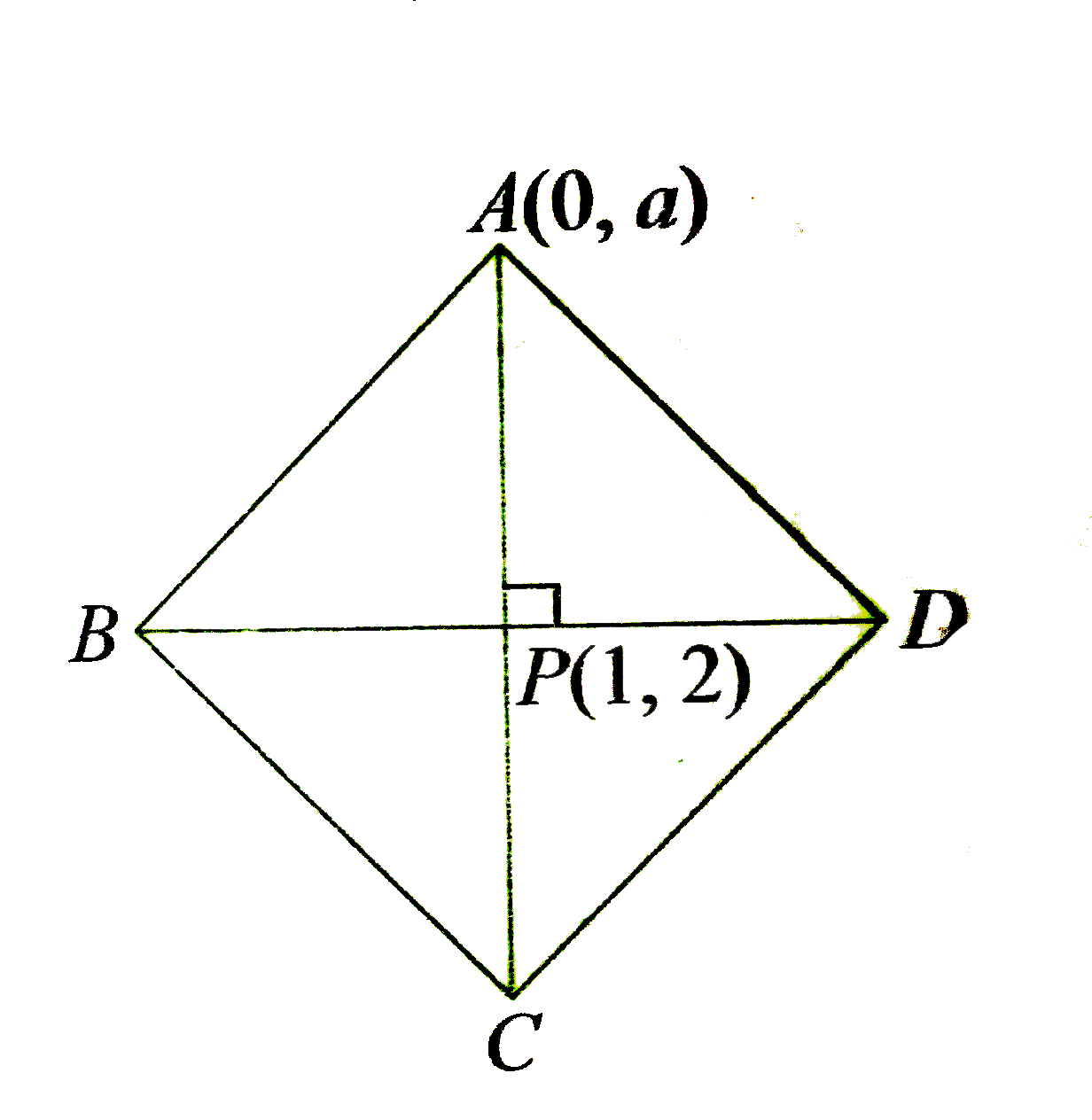Two sides of a rhombus ABCD are parallel to the lines y = x + 2 and y = 7x + 3 If the diagonals of the rhombus intersect at the point (1, 2) and the vertex A is on the y-axis, then vertex A can be Solution in Bengali
The correct Answer is:(0,0) or (0,5/2)
A being on the y-axis may be chosen as (0,a). The diagonals intersect at P(1,2).

Again, we know that the diagonals will be parallel to the bisectors of the two given lines y=x+2 and y =7x+3, i.e.,
x−y+2√2=±7x−y+35√2
or 5x-5y+10 =±(7x−y+3)
or 2x+4y-7=0 and 12x-6y+13=0
∴Slope of diagonals are m1=−1/2andm2=2. Let diagonal d1 be parallel to 2x+4y-7 =0 and diagonal d2 be parallel to 12x-6y+13 = 0. The vertex A could be on any of the two diagonals. Hence, the slope of AP is either -1/2 or 2. Therefore,
2−a1−0=2or−12
i.e.,a=0or52
Hence, A is (0,0) or (0,5/2).
Topper's Solved these Questions
- BOOK - CENGAGE PUBLICATIONCHAPTER - STRAIGHT LINESEXERCISE - CONCEPT APPLICATION EXERCISE 2.65videos
STRAIGHT LINES
- BOOK - CENGAGE PUBLICATIONCHAPTER - STRAIGHT LINESEXERCISE - EXERCISE (SINGLE CORRECT ANSWER TYPE)82videos
STRAIGHT LINES
- BOOK - CENGAGE PUBLICATIONCHAPTER - STRAIGHT LINESEXERCISE - CONCEPT APPLICATION EXERCISE 2.48videos
STRAIGHT LINES
- BOOK - CENGAGE PUBLICATIONCHAPTER - STRAIGHT LINEEXERCISE - Multiple Correct Answers Type8videos
STRAIGHT LINE
- BOOK - CENGAGE PUBLICATIONCHAPTER - THEORY OF EQUATIONSEXERCISE - JEE ADVANCED (Numerical Value Type )1videos
THEORY OF EQUATIONS
Similar Questions
If aandb are two arbitrary constants, then prove that the straight line (a−2b)x+(a+3b)y+3a+4b=0 will pass through a fixed point. Find that point.
03:44View SolutionFind the equations of the diagonals of the square formed by the lines x=o,y=0,x=1andy=1.
05:44View SolutionThe point (8,−9) with respect to the lines 2x+3y−4=0 and 6x+9y+8=0 lies on
06:06View SolutionThe point P(α,α+1) will lie inside the triangle whose vertices are A(0,3),B(−2,0) and C(6,1) if
01:32View SolutionThe number of distinct real roots of x4−4x3+12x2+x−1=0is_____.
06:42View SolutionTwo sides of a rhombus ABCD are parallel to the lines y = x + 2 and y = 7x + 3 If the diagonals of the rhombus intersect at the point (1, 2) and the vertex A is on the y-axis, then vertex A can be
06:30View SolutionA rhombus has two of its sides parallel to the lines y=2x+3andy=7x+2. If the diagonals cut at (1, 2) and one vertex is on the y-axis, find the possible values of the ordinate of that vertex.
07:29View SolutionTwo sides of a rhombus ABCD are parallel to the lines y = x + 2 and y = 7x + 3. If the diagonals of the rhombus intersect at the point (1, 2) and the vertex A is on the y-axis, find the possible coordinates of A. x – y – 1 = 0 are the equations of two internal bisectors of its angles.
09:00View SolutionThe straight lines y=x=2andy=6x+3 are parallel to two sides of the rhombus ABCD. If the vertex A lies on y-axis and the diagonals of the rhombus intersect at (1,2) find the coordinat of A.
04:56View SolutionTwo sides of a rhombus ABCD are parallel to the lines x−y=5and6x−y=3. If the diagonals of the rhombus intersects at the point (2,1), find the equation of the diagonals. Further, find the possible coordinates of the vertex A if it lies on the x-axis.
04:16View SolutionThe sides of a rhombus ABCD are parallel to the lines x−y+2=0 and 7x−y+3=0, If the diagonals of the rhombus intersect at P(1,2) and the vertex A (different from the origin) is on the y-axis then the ordinate of A is:
07:29View Solutionसमचतुर्भुज ABCD की दो भुजाए रेखाओं y = x + 2 तथा y = 7x + 3 के समान्तर हैं। यदि समचतुर्भुज के विकर्ण बिन्दु (1, 2) पर एक दूसरे को प्रतिच्छेद करते हैं और शीर्ष A, y-अक्ष पर स्थित है, तब A के संभव निर्देशांक ज्ञात कीजिए।
View SolutionTwo sides of a rhombus ABCD are parallel to the lines y = x + 2 and y = 7x + 3 If the diagonals of the rhombus intersect at the point (1, 2) and the vertex A is on the y-axis, then vertex A can be
04:09View SolutionTwo sides of a rhombus ABCD are parallel to the lines y = x + 2 and y = 7x + 3 If the diagonals of the rhombus intersect at the point (1, 2) and the vertex A is on the y-axis, then vertex A can be
04:16View SolutionTwo sides of a rhombus ABCD are parallel to the lines y = x + 2 and y = 7x + 3 If the diagonals of the rhombus intersect at the point (1, 2) and the vertex A is on the y-axis, then vertex A can be a. (0,3) b. (0,5/2) c. (0,0) d. (0,6)
05:44View SolutionThe two sides of rhombus ABCD are parallel to y = x + 2 and y = 7x + 3. If the diagonal points (1, 2) of the rhombus intersect each other and the vertex A lies on the y-axis, then find the possible coordinates of A.
03:22View Solution

